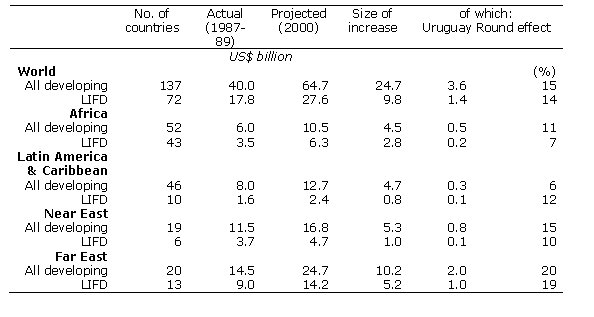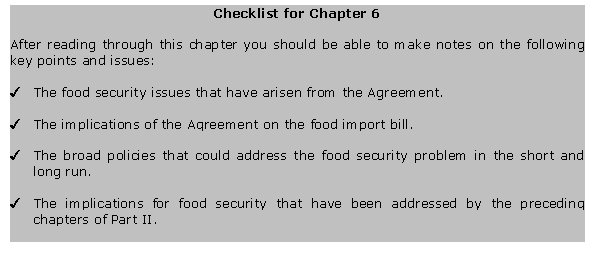|
The implications of the Uruguay Round Agreement on Agriculture for developing countries |
|||||
|
|
|||||
|
Chapter 6: The implications for food security |
|||||
|
What this chapter is about
The coming decades will pose increasingly complex issues for national policy makers in developing countries, with food security being paramount among these. The previous chapters have drawn attention to the importance of the food security issue in the wake of the external trading changes that are likely to arise from the Agreement. A common theme in Chapters 4 and 5 was that the impact of the Agreement was going to be most significant for consumers and subsequent consumption policies in net food-importing countries.
In this chapter, we focus specifically on the food security issue. Food security in some countries may be adversely affected and could present formidable challenges for policy makers. The response is likely to encompass further structural changes to these economies in addition to support from the international community.
Aims of this chapter
What you will learn
6.1 The agreement and food security
The Agreement indirectly addresses food security issues via the Special and Differential measures and, as we have seen throughout the Manual, these are an integral part of the Agreement for developing countries. It allows developing countries more time and smaller reductions in the areas of market access, domestic policies and export subsidies. In addition the de minimis commitment is raised to 10% and there are further exemptions related to input subsidies and export marketing. These were discussed at length in chapters 2 and 3.
The Marrakech Ministerial Meeting foresaw, and acknowledged, these likely negative effects and that the Special and Differential treatment in the Agreement for developing and Least Developed Countries would need to be supplemented with special measures. The important measures adopted at the Marrakech Meeting were:
The Decision addresses the issue of food security by:
However, in meeting these objectives the Decisions fall short in providing concrete measures with regard to implementation. The following points have been made with respect to the Decisions:
Implementation of the Decisions has yet to address:
6.2 Assessing the implications of the Agreement on food security
We have seen that the projections carried out by FAO to the year 2000 forecast a substantial rise in world agricultural trade. However, despite the gains in trade and the ability of the worlds productive capacity to meet effective global demand for food, there will be considerable regional variations, with certain areas receiving no improvement in food security.
Estimates to the year 2020 by the International Food Policy Research Institute (IFPRI) estimate that there will be very little reduction in the number of malnourished children in the developing world as a whole. Whilst in Sub-Saharan Africa and South Asia, the number of malnourished children may actually increase. (Rosegrant 1995)
Food security is defined by FAO to have three dimensions: food supply; access to food; and stability of flows over time. The changes in the external policy environment will influence national food security in three ways.
6.2.1 Influencing the foreign exchange earning capacity
In chapter 4 we saw that the potential foreign exchange earnings could be increased as a result of the improvements in market access, although the effect could be limited in the short to medium term, unless there is an effective supply response. More importantly, as we have discussed in Part II, the response in production will depend upon the overall policy environment in particular developing countries.
Equally important is the focus of the Agreement upon the temperate products of developed countries. Price increases are concentrated on these products. For example, there are likely to be increases in cereal prices: developing countries have a 10% share of cereal exports, alongside a 40% share of world imports. Thus, there is a likely negative impact. The loss in preferential margins will also have a negative effect on foreign exchange earnings in Latin America and Africa.
Overall, the ability of developing countries to make adequate gains via export earnings to meet the increase in food import bills may be limited. Developing countries as a whole are expected to improve their trade balances by some US$ 7.5 billion between the base period and 2000, of which US$ 3.1 billion can be attributed to the Agreement. However, these gains are unlikely to be shared equally: in Sub-Saharan Africa, where per caput food availability is low, the rise in the import bill is unlikely to be offset by gains in other sectors.
6.2.2 Influencing the price of food imports and market stability
The increased project prices in the FAO forecasts point towards an increase in the food import bill. The domestic policy reforms in developed countries will see the reduction in production for major agricultural food commodities, although this reduction in production and consequent upward pressure on food prices will be spread over a number of years during the implementation.
The impact on the food import bill is highlighted in table 7.1. It shows that between 5 and 20% of increases in the food import bill to the year 2000 can be attributed to the Agreement. In the Low-Income Food-Deficit Countries the import bill is projected to rise by US$ 10 billion, of which 14% can be attributed to the impact of the Agreement on world market prices.
6.2.3 Influencing the availability of food assistance
The Decision compensates for the increased food import bill by accommodating the need for greater food aid. The Agreement is unlikely to affect the provision of food aid directly. However, the reduction in export subsidies and other price support in developed countries is likely to reduce the level of cereal stocks which were in many cases used to fulfil food aid requirements.
Table 6.1 Food import bills of developing and low-income food-deficit countries, past and crojected
Influences will also come from events other than the Agreement. Two critical influences are reform programmes currently taking place in the CAP of the EU; and the transition of formerly centrally planned economies. A successful transition of the latter is likely to mitigate some food price increases as increased supplies arrive on the market.
IFPRI projections to 2020 looked at food projections in the context of different investment and trade scenarios, and therefore included the implications of the Agreement on Agriculture. The global projections of supply and demand of food highlight that the world is at risk of maintaining a two-tiered system of food security, with rich and rapidly growing countries enjoying abundant, affordable food supplies and poor countries suffering from malnutrition and food insecurity. It is argued that national governments need to devise policy responses that address this imbalance through their agricultural and social investment decisions. This would greatly improve food security and reduce malnutrition in developing countries.
6.3 Policy responses in addressing food security
A number of policy responses could be devised in conjunction with compensatory, and food aid, support from the international agencies. IFPRI has predicted that the aggregate global supply and demand for food is relatively good if governments and the international community direct policy commitments towards agricultural growth, via cost effective investment in agricultural research, extension, irrigation and water development, human capital and rural infrastructure. These represent the key elements in any policy strategy towards addressing food security in the long run.
We highlight below some more specific polices which policy makers may wish to consider. Some of the policies have been discussed in the context of the preceding chapters but we will highlight them again here.
| |||||

